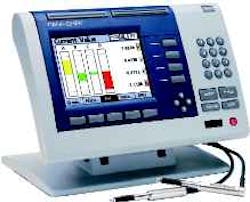FIXTURE GAGING QUALITY
Go/no-go hard gaging gets the power and flexibility of microprocessing.
By William ChambersThe Gage Chek system offers a middle ground between simple and computer-based fixture gaging.
Numerical values, along with visual and audio cues, make the Gage Chek familiar to operators accustomed to using column gages or dial indicators.
In its integrated SPC functions, Gage Chek displays X-bar and R charts that show up red when processes exceed control limits.
Unlike complex measuring methods, fixture gaging is less labor intensive, requires minimal training to operate, and offers an inexpensive alternative for measuring relatively simple parts. Such plain go/no-go hard-gaging technology may seem dated to most. But when combined with the power and flexibility of microprocessors, it provides a middle ground between simple fixture-gaging systems with DRO or column displays and those that are computer based.
One example is the Gage Chek multifunction gage amplifier from Metronics, which features a microprocessor-based display that shows not only the number value of a part being measured, but also gives visual and audio cues when parts fail. Measurements close to nominal values are green, warning levels appear yellow, and outoftolerance conditions are red.
Such color cues are familiar to operators accustomed to column gages or dial indicators. In addition, sophisticated computations happen in the background, and users can program the system's relay connection to automatically open and close if certain conditions are met, providing instant feedback when dimensions fall out-of-tolerance.
Gage Chek's direct probe outputs — which combine algebraically and mathematically for thickness, flatness, dwell angles, and maximum tip heights — display results numerically and graphically. Users can also archive these results for process studies, such as simple statistical control. Trigonometric formulas convert linear measurements into angular ones, while other formulas are customizable to handle TIR, volume, angles between camshaft lobes, and more.
The system's integrated statisticalprocess-control (SPC) functions eliminate sending data to an external SPC program. It displays data tables with range, mean, maximum, minimum, and standard-deviation information. Operators view X-bar and R charts that show up red when the process exceeds control limits.
Over 40 math and trigonometric functions and operands are available. Operators output as many as 16 separate values from these formulas, based on single input channels or combinations and comparisons of multiple ones.
For monitoring out-of-tolerance conditions, Gage Chek handles eight probe inputs and two outside-relay outputs. Compatible inputs include Heidenhain length gages, air gages, LVDTs, HBTs, and more.
Since shops using display devices should have access to external interfaces, Gage Chek connects to PCs and equipment for data collection, print-out reports, and other documentation requirements. With the system's integrated SPC functions, operators correct processes before manufacturing out-of-tolerance parts. An SPC database lets them store and retrieve measurement information and check manufacturing processes at each gage and share data locally or globally.
The most-effective system
Before creating a fixture and a part program, shops must plan ahead and consider application requirements to save time and money. By asking some key questions, they can design and select the most effective system, regardless of measuring equipment type — whether fixture gaging or CMM.
How many dimensions are needed? Shops can view all data or just end results. For instance, a TIR is the maximum-position value minus the minimumposition value. Should just the TIR decrease the amount of data lower, or are maximum and minimum values desired?
What specific formulas are needed? Shops should have measuring goals in mind. If they want an angle, for example, a trigonometry function works. Or if an external device needs triggering, a formula that controls a relay or I/O line is required.
What are the tolerances? Concerning how tolerances are written, shops need to decide if they want a warning zone for parts that approach the out-of-spec condition and determine the accuracy and resolution. In general, it is wise to specify gaging that has 5 to 10 the accuracy capability of a current application to prepare for future needs.
Are results units or numeric (unitless numbers)? Consider the math involved. Inches or millimeters times each other are squared or cubed. Divided they are ratios, which are unitless numbers.
What to do with the data? Choices include displaying data without recording it, creating printed reports directly to a printer, and sending it to a computer. Shops can also use data for SPC purposes such as charting histograms, attributes, X-bar, R, and more.
How are parts staged or contacted? Contacting parts with conventional probes or going noncontact is an important consideration. Once decided upon, shops need to know how many are needed, whether or not to hold/ fixture them, and if measuring is taking place in-process (during manufacturing) or post process.
Mr. Chambers is a product specialist for Metronics Inc., Bedford, N.H.
